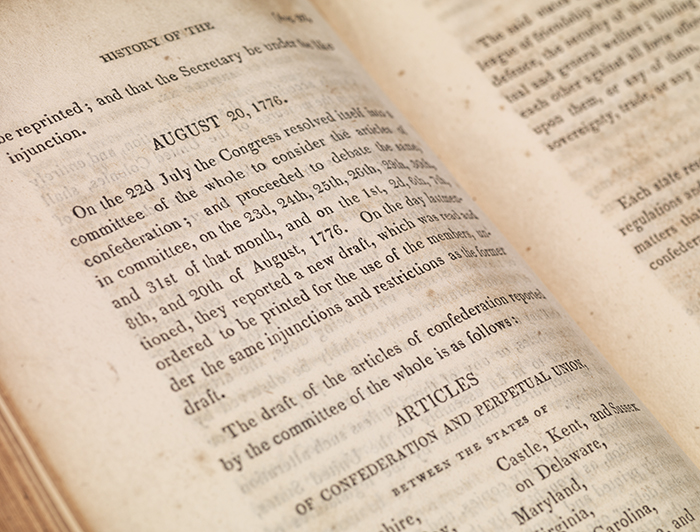
SECRET JOURNALS OF CONGRESS, 1821, VERY SCARCE AND IMPORTANT FOUR-VOLUME WAIT PRINTING AUTHORIZED BY CONGRESS—CONTAINING THE OFFICIAL ACCOUNT OF THE 1787 CONSTITUTIONAL CONVENTION, INCLUDING BOTH FRANKLIN'S 1775 'SKETCH' FOR THE ARTICLES OF CONFEDERATION AND JOHN DICKINSON'S JULY 12, 1776 DRAFT
(CONSTITUTION) (MADISON, James). Secret Journals of the Acts and Proceedings of Congress, from the First Meeting Thereof to the Dissolution of the Confederation, by the Adoption of the Constitution of the United States. Boston: Thomas B. Wait, 1821. Four volumes. Octavo, period-style half tan calf and marbled boards, red morocco spine labels. $8200.
1821 second edition of the Secret Journals of the Acts and Proceedings of Congress, featuring Benjamin Franklin's "sketch of the Articles of Confederation" as submitted to the Convention on July 21, 1775, and the official publication of both John Dickinson's July 12, 1776 draft of the Articles of Confederation and the subsequent August 20, 1776 draft of the Articles, preceded only by the extraordinarily rare 1820 edition issued by the same Boston publisher. A splendid four-volume set, rarely found complete.
In the early 1800s, as "50th Anniversary celebrations of successive events of the Revolution began, a wave of historical curiosity would sweep the country, aided and abetted by government-sponsored publications" (Powell, 114). At the center of interest was the 1787 Philadelphia Convention that had been empowered by the Congress of the Confederation to recommend amendments to the Articles of Confederation. "The Convention decided, however, to discard the Articles and to devise an entirely new government. When the framers were done they bypassed the Congress and submitted the new Constitution directly to the states, which were called upon to organize popular conventions to ratify their actions and adopt the Constitution. The framers appealed to the people directly… [believing] that only the people themselves could compact together to ordain the Constitution" (Lutz & Warren, Covenanted People, 47).
Benjamin Franklin, Alexander Hamilton and James Madison were among the 65 delegates, and upon election as president of the Convention, Washington appointed Hamilton and several others "to a small committee that drew up rules and procedures for the convention… To encourage candor, the committee decided that 'nothing spoken in the House be printed, or otherwise published or communicated without leave.' Journalists and curious spectators were forbidden to attend, sentries were stationed at doors, and delegates, sworn to secrecy, remained tight-lipped to outsiders. The delegates even adjourned to the second floor of the State House to ensure confidentiality. During a sultry Philadelphia summer, in the face of thick swarms of tormenting flies, the blinds were often drawn and the windows shut to guarantee privacy. Even Madison's copious notes of the convention were not published until decades later." Kept secret in the belief that open deliberations would fuel divisiveness, these "close-door proceedings yielded inspired, uninhibited debate and brought forth one of the most luminous documents in history." The Constitution was ultimately adopted and signed by the Convention on September 17, 1787 and submitted to the Continental Congress on September 28, 1787, with the suggestion that it be submitted to the states for ratification. But the veil of secrecy would make the Convention's "inner workings the stuff of baleful legend," encouraging many to suspect "a wicked cabal at work." Patrick Henry, for one, railed against the 'tyranny of Philadelphia" and much of the ensuing dispute produced an often poisonous rancor, ushering "in a golden age of literary assassination in American politics" that persisted even after the Constitution's ratification (Chernow, 228, 244). Knowledge of these secret debates was available only from Madison's journal and a handful of documents deposited by Washington at the Department of State in 1796. This very scarce second edition, issued by the same publisher the year after the exceedingly rare first edition, documents the momentous 1787 Convention and the revolutionary ideas that led to its realization, providing vivid access to the drama that created a nation. Secret Journals was the first official collection to print Benjamin Franklin's "sketch on the Articles of Confederation" as submitted by him to the Committee of the Whole on July 21, 1775 (Domestick Affairs:283-289). Though Franklin's proposal was initially rejected, much of his plan was incorporated into John Dickinson's draft of the Articles (Domestick Affairs:290-304). Called into service for the Continental Army, Dickinson's handwritten manuscript was read before the Continental Congress on July 12, 1776. Also herein is the August 20, 1776 draft of the Articles of Confederation and Perpetual Union (Domestick Affairs:304-315). In addition to containing such crucial documents, Secret Journals contains essential information on the proceedings through 1788. Domestick Affairs (Volume I) with front advertisement leaf dated in print August 1820. Occasional mispagination as issued without loss of text. Farrand's Records of the Federal Convention of 1787. Sabin 15594. Shaw & Shoemaker 7481.
Text generally fresh with only light scattered foxing. A near-fine copy, handsomely bound.